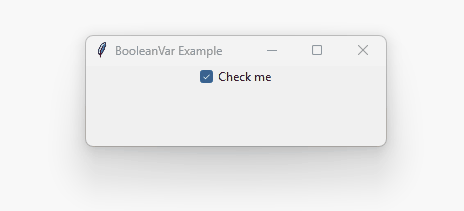Summary: In this tutorial, you’ll learn how to use the Tkinter BooleanVar class to track the boolean state of a widget.
Introduction to Tkinter BooleanVar #
In Tkinter, the BooleanVar class is a subclass of the Variable class. It is a variable class that holds a boolean value.
Like StringVar, IntVar, and DoubleVar, you can use the BooleanVar object to track the boolean state of a widget such as a RadioButton or CheckButton.
When you link a BooleanVar object with a widget, you can easily track and change widget values from your Python code.
Linking means establishing a two-way binding between a BooleanVar object and the widget’s state. This results in automatic value synchronization between the two.
In Tkinter, you can link a BooleanVar object with the following widgets:
- CheckButton
- RadioButton
- Menu CheckButton
Creating a BooleanVar object #
To create a BooleanVar object, you follow these steps:
First, import Tkinter:
import tkinter as tkCode language: JavaScript (javascript)Second, create an instance of the BooleanVar class:
boolean_var = tk.BooleanVar()A BooleanVar object defaults to False. If you want to set its value to True, you can use the following:
boolean_var = tk.BooleanVar(value=True)Code language: PHP (php)Note that you have to use the value keyword argument because the first parameter of the BooleanVar constructor is a master widget.
Linking a BooleanVar object with a widget #
Once having a BooleanVar object, you can link it with a widget. For example, you can link a BooleanVar object with a CheckButton as follows:
check_button = ttk.Checkbutton(variable=boolean_var)Note that you can link one BooleanVar object with one or more widgets.
Manipulating widget’s values #
After linking a BooleanVar object with a widget, you can track and change the widget’s value via the BooleanVar object.
For example, you can access the current value of the CheckButton using the get() method of the BooleanVar object:
boolean_var.get()Code language: CSS (css)You can also check the CheckButton by setting the value of the BooleanVar object to True:
boolean_var.set(True)Code language: CSS (css)Tkinter BooleanVar example #
The following program illustrates how to use a BooleanVar to manage the state of a CheckButton widget:
import tkinter as tk
from tkinter import ttk
from tkinter.messagebox import showinfo
root = tk.Tk()
root.title("BooleanVar Example")
root.geometry("300x80")
check_var = tk.BooleanVar(value=True)
check_button = ttk.Checkbutton(
root,
text="Check me",
variable=check_var,
command=lambda: showinfo(
title="Checkbutton State",
message= "Checked" if check_var.get() else "Unchecked"
)
)
check_button.pack()
root.mainloop()Code language: JavaScript (javascript)
How the program works
First, create a BooleanVar with the default value True:
check_var = tk.BooleanVar(value=True)Code language: PHP (php)Second, create a CheckButton widget and link it with the check_var button:
check_button = ttk.Checkbutton(
root,
text="Check me",
variable=check_var,
command=lambda: showinfo(
title="Checkbutton State",
message="Checked" if check_var.get() else "Unchecked"
)
)Code language: JavaScript (javascript)If you check or uncheck, the CheckButton will execute a lambda to show the current value retrieved from the check_var variable.
Summary #
- Use a
BooleanVarobject to track and control the boolean state of a widget.